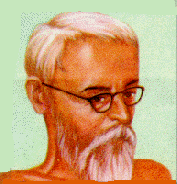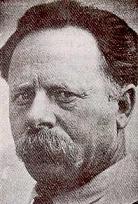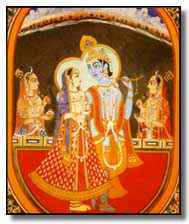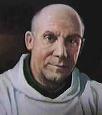|
Page < 1 2 3 4 5 6 7 8 9 10 11 12 13 14 15 16 17 18 19 20 21 22 23 24 25 >
Show
in alphabetical order
 81. Ramanuja
(1017-1137) was, like Sankara, a great
exponent of Visistadvaita Vedanta, was
concerned with the same problems, and adopted the same assumptions and texts.
But they came to entirely different conclusions because while Sankara was
intellectual, Ramanujan was devotional. Sankara's cold and relentless logic made
him identify the soul with Nirguna Brahman while Ramanuja's devotional spirit
led him along the Bhakti Marga. 81. Ramanuja
(1017-1137) was, like Sankara, a great
exponent of Visistadvaita Vedanta, was
concerned with the same problems, and adopted the same assumptions and texts.
But they came to entirely different conclusions because while Sankara was
intellectual, Ramanujan was devotional. Sankara's cold and relentless logic made
him identify the soul with Nirguna Brahman while Ramanuja's devotional spirit
led him along the Bhakti Marga.
Ramanjua's teachings were based on the Vaishnava
mystical Tamil poems, the Upanishads, theBrahma Sutras and the Puranas. He
regarded the Brahman as the Supreme Reality, free from imperfections and
possessing innumerable auspicious qualities of unparalleled excellence. He is
the Lord or Ishvara and the highest person or Purushottama.
" The Bhagavad-Gita was spoken by Lord Krishna to
reveal the science of devotion to God which is the essence of all spiritual knowledge."
The
Supreme Lord Krishna's primary purpose for descending and incarnating is relieve the world
of any demoniac and negative, undesirable influences that are opposed to spiritual
development, yet simultaneously it is His incomparable intention to be perpetually
within reach of all humanity. "
(source: Main
Currents in India Culture - By S. Natarajan
p. 37-39 Indo-Middle East Cultural Studies Hyderabad 1960).
82.
Serge Elisseev
- Asian scholar,
author of several books, Etudes
D'Orientalisme, Publiees Par Le Musee Guimet a La Memoire De Raymonde Linossier:
Notes Sur Le Portrait En Extreme-Orient and
Peinture
Contemporaine au Japon says:
" The East is impenetrable to the West only for the man who
deliberately refuses to get rid of certain ideas which, like armor, prevent him from
bending . . . The teaching of the great Indian thinkers
could spiritually enrich the European soul. In the course
of its history, the European civilization has lost most of its spiritual values. It can no
longer recover them though it still realizes their necessity. For the best of men cannot
exist simply on the ideal of "efficiency of work" in the American way. In the
condition in which the West finds itself, it is easier for us to go and search for truths
in the India, than to come back to the few values we have left in the course of the
development of our civilization."
83. Dr. Albert Schweizer
(1875-1965)
humanitarian, theologian, missionary, organist, and medical doctor.
"The Bhagavad-Gita has a profound
influence on the spirit of mankind by its devotion to God which is manifested by
actions."
84. Richard Waterstone
( ? ) studied Sanskrit at the University of Edinburgh, journalist, creator
of BBC documentary, author, comments in his book on India:
Living Wisdom
 "Shiva's dance is a symbol
of the unity and rhythm of existence. The unending dynamic process of creation
and destruction is expressed in the energetic posture of the god. Shiva dances
in a ring of fire that refers to the life-death process of the universe." "Shiva's dance is a symbol
of the unity and rhythm of existence. The unending dynamic process of creation
and destruction is expressed in the energetic posture of the god. Shiva dances
in a ring of fire that refers to the life-death process of the universe."
"There is a striking resemblance
between the equivalence of mass and energy symbolized by Shiva's
cosmic dance
and the Western theory, first expounded
by Einstein, which calculates the amount of energy contained in a subatomic particle by
multiplying its mass by the square of the speed of light : E=mc2. "
"Well before 700 BC. Hindu
sages were chanting neti neti (not that, not that), denying the ultimate reality
of an external world in which they saw little more than illusion, and searching
instead for the eternal spark of Brahman in the soul within all beings.
(source: India:
Living Wisdom - By
Richard Waterstone p.
134-135 and 22).
 85. Roger Housden
( ? ) author of Travels
Through Sacred India and a student of the spiritual
traditions of India for over 20 years, concurs in his book: 85. Roger Housden
( ? ) author of Travels
Through Sacred India and a student of the spiritual
traditions of India for over 20 years, concurs in his book:
"Time, for example, is intimately connected with the
goddess Kali,
which partly
accounts for her destructive nature. Energy - in Einstein's equation, E=MC2 - is
personified in India as Shakti in her various guises."
"...The magnificent
portrayal of Lord Krishna in the Bhagavad Gita, when he appears to Arjuna and
gives him the most profound of spiritual teaching."
"India is a vast network of
sacred places. The entire country is a sacred land. The sacrality of the land of
India, is what, still today, gives a sense of unity to this country of so many
religions, cultures, races and factions."
 "The
Ganga is a living
presence, a protector, a healer of ills. The Ganga is as alive as it ever was
with the hopes and dreams of an entire culture. Countless flowers are strewn
across her body daily; millions of lights set sail every evening upon her
waters. While stories of gods and goddesses come and go with the ages, while one
myth replaces or rivals another, the organic presence of Ganga continues as
ever, absorbing her devotees' offerings and ashes in the same way she has done
since time immemorial." "The
Ganga is a living
presence, a protector, a healer of ills. The Ganga is as alive as it ever was
with the hopes and dreams of an entire culture. Countless flowers are strewn
across her body daily; millions of lights set sail every evening upon her
waters. While stories of gods and goddesses come and go with the ages, while one
myth replaces or rivals another, the organic presence of Ganga continues as
ever, absorbing her devotees' offerings and ashes in the same way she has done
since time immemorial."
"Christian missionaries, and Muslim invaders even more
so, were naturally shocked at the profusion of ‘idols’ they found in every
town and village in the country. Their distaste, however, was caused more by
their own literalist manner of thinking than by any intrinsic inadequacy in the
Hindu religion. The three religions of the Near East are all religions of the
book. The word, which they all depend on, tends inevitably towards
concretization: this is the truth, so that must be false. Once cast in stone,
the truth has no freedom of movement. It becomes linear, set down for all time,
and casts a shadow as dark as its words are bright. Hinduism
had no founder, and no single book, foundation or organization to set uniform
standards and rules. As in life, all the subtle variations of light and dark
thrive there, and are indeed encouraged to do so.”
 (source:
Travels
Through Sacred India - By
Roger Housden p. 56-57,
73, and
2 -23).. (source:
Travels
Through Sacred India - By
Roger Housden p. 56-57,
73, and
2 -23)..
86. Vinoba
Bhave, (1894-1982), the great spiritual leaders and
social reformers of modern India, was a disciple of Mahatma Gandhi. Founder of the
Bhoodan, or land-gift, movement, seeking donations of land
for redistribution to the landless, said :
"The Supreme Lord of the Gita confirms
the faith of each and grants the rewards each seeks....No matter what we revere, so long
as our reverence is serious, it helps progress."
"Hinduism gives its followers
complete freedom. It does not insist on any
particular discipline or prayer. Religion has to release us from bondage. The only
imperative commandment it can have is to ask us to purify ourselves. Hinduism has
emphasized the need for inner purity. Indian civilization and culture has shown a
tremendous capacity for assimilation and absorption. If Hinduism becomes narrow, we shall
be destroying our precious heritage. "
87. Jacob Wilhelm Hauer (1881-1961)
was born in Ditzingen, Wuerttemberg. His parents were pietists. Hauer was
trained as a missionary. He taught at a mission school in India from 1907
onwards. He studied and taught Sanskrit. He wrote several books on Hinduism and
Yoga. Confronted with Hinduism, he became interested in
the religion and no longer regarded Christianity as the sole means of salvation.
He
gave to the
Bhagavad Gita,
a central
place in the German faith. Hauer also wrote on Yoga. His major work was Der
Yoga als Heilweg
("Yoga as a means of salvation") in 1932.
Hauer dedicated to
C. G. Jung.
 He afforded the Bhagavad-Gita, a pivotal role in
the spiritual life of Germany. An official interpreter of faith in Germany,
Hauer described the Gita, as "a work of
imperishable significance" that offers: He afforded the Bhagavad-Gita, a pivotal role in
the spiritual life of Germany. An official interpreter of faith in Germany,
Hauer described the Gita, as "a work of
imperishable significance" that offers:
"gives
us not
only profound insights that are valid for all times and for all religious life,
but it contains as well the classical presentation of one of the most
significant phases of lndo-German religious history. . . .It shows us the way as
regards the essential nature and basal characteristics of Indo-Germamic
religion. Here Spirit is at work that belongs to our Spirit.
"We are not called to solve the meaning of
life but to find out the Deed demanded of us and to work and so, by action, to
master the riddle of life."
Hauer declared the central
message of the Gita:
"We are not called
to solve the meaning of life but to find out the Deed demanded of us and to work
and so, by action, to master the riddle of life."
(source: Introductory
Essay to The Bhagavad-Gita - By S. Radhakrishnan 1997, New Delhi:
Harper Collins Publishers India, 1993, p. 11).
88. W. Norman
Brown professor of Sanskrit at University
of Pennsylvania, author of several books, including Mahimnastava
or Praise of Shiva's Greatness,
Mythology of India
has stated:
" As a religion, Hinduism has set side by side in peaceful coexistence every shade of
belief ranging from the most primitive sort of animism to a highly sophisticated
philosophical monism, and with this has gone a corresponding range of worship of practice
extending from the simplest disease spirits to the most concentrated meditation designed
to produce knowledge of abstract impersonal reality."
 89. Bal
Gangadhar Tilak
(1856-1920) freedom fighter, great Sanskrit scholar and astronomer.
He was an ardent patriot and a born fighter. He
has been called the Father of Indian Nationalism.
He is the author of The Orion
and The Artic Home in the Vedas
in English and of Gita
Rahasya in Marathi. He was the fearless
editor of the two leading newspapers of the Deccan - the Kesari and the Mahratta.
He suffered imprisonment thrice - one of them a rigorous one for twelve months
in 1897 and deportation to Manadalay . 89. Bal
Gangadhar Tilak
(1856-1920) freedom fighter, great Sanskrit scholar and astronomer.
He was an ardent patriot and a born fighter. He
has been called the Father of Indian Nationalism.
He is the author of The Orion
and The Artic Home in the Vedas
in English and of Gita
Rahasya in Marathi. He was the fearless
editor of the two leading newspapers of the Deccan - the Kesari and the Mahratta.
He suffered imprisonment thrice - one of them a rigorous one for twelve months
in 1897 and deportation to Manadalay .
His
contribution to modern India stands on par with that of Mahatma
Gandhi's. Proclaimed to the nation, "Swaraj is my birthright and
I shall have it!" Wrote his famous commentary on Bhagavad-Gita,
the sacred
book of Hindus.
He stressed that Gita taught Karma (action), nothing but action. Religion or spiritual message were
secondary and the need of the hour was to arise and fight. This was Lord Krishna's message
to Arjuna.
He explained: "The most
practical teaching of the Gita, and one for which it is of abiding interest and
value to the men of the world with whom life is a series of struggles, is not to
give way to any morbid sentimentality when duty demands sternness and the
boldness to face terrible things."
(source:
The
Soul of India- By Amaury de Riencourt
p. 301).
"The Shrimad Bhagavad
Gita is one of the most brilliant and pure gems of our ancient sacred books. It
would be difficult to find a simpler work in Sanskrit literature ore even in all
the literature of the world than the Gita,
which explains to us in an unambiguous and succinct manner the deep, and sacred
principles of the sacred science of the SELF (Atman), after imparting to us the
knowledge of the human body and the cosmos, and on the authority of those
principles acquaints every human being with the most perfect and complete
condition of the Self...."
(source: Gita
Rahasya - By B. G. Tilak
p. 1).
 90.
Leopold von Schroeder
(1851-1920) German Indologist. In 1884, Schroeder published Pythagoras
und die Inder, Eine Untersuchung ueber Herkunft und Anstammung Pythagoreischer
Ideen - Pythagoras and the Indians. An examination of the origin and
derivation of the ideas of Pythagoras. 90.
Leopold von Schroeder
(1851-1920) German Indologist. In 1884, Schroeder published Pythagoras
und die Inder, Eine Untersuchung ueber Herkunft und Anstammung Pythagoreischer
Ideen - Pythagoras and the Indians. An examination of the origin and
derivation of the ideas of Pythagoras.
He says:
"The Indians are the nation of
romanticists of antiquity. The Germans are the romantics of modern times. Sentimentality
and feelings for Nature are common to both German and Indian poetry. He concludes that all
the romantic minds of the West turn towards India because of the deep-rooted similarity
between romanticism in Europe."
"Nearly all the
philosophical and mathematical doctrines attributed to Pythagoras are derived
from India."
(Off all the European nations Germany's response to
India was most enthusiastic and open hearted).
(source: German
Indologists – By Valentina Stache-Rosen
p. 117 – 118).
 91. Jagdish
Chandra Bose (1858-1937),
a pioneer of modern Indian science, combined ancient Indian introspective methods with
modern experimental methods to demonstrate "the universal livingness of matter"
or the "omnipresence of Life in Matter." 91. Jagdish
Chandra Bose (1858-1937),
a pioneer of modern Indian science, combined ancient Indian introspective methods with
modern experimental methods to demonstrate "the universal livingness of matter"
or the "omnipresence of Life in Matter."
Modern science thus endorsed the ancient Upanishadic
truth that the entire universe is born of a life-force and is quivering
with a touch of animation. His work represents the triumph of spirituality over extreme
materialism.
(source:
India and World Civilization
- By D. P. Singhal Pan Macmillan Limited. 1993.
p. 266).
 92. Kenneth Walker
( ? ) a
famous British surgeon, has devoted a good deal of time and writing to the study of Indian
thought and literature in search of an answer: 92. Kenneth Walker
( ? ) a
famous British surgeon, has devoted a good deal of time and writing to the study of Indian
thought and literature in search of an answer:
The eminent English thinker,
presiding over the Sri Ramakrishna birthday anniversary meeting in London in
March, 1949, said:
"If the two great nations,
India and England, cannot be united by political chords, the ties of spiritual
and intellectual co-operation will certainly prove a stronger bond of union. India,
the greatest spiritual force of the world, even
maintains today those fountain sources of eternal life, which are the only hope
of the spiritual resurrection of humanity."
(source:
The
Vision of India - By Sisirkumar Mitra
p. 209 -210).
"From the point of view of science, we see man as an elaborate piece of mechanism,
his actions determined by his central nervous system and his environment. From philosophy
we learn that his capacity for knowledge is strictly limited, so that by means of his
sense organs alone he can never know reality. This is confirmed by Hindu philosophy, but a
new idea is added. Man, as he is can see no more and do no more, but by right effort and
right method, he can gain powers, understand more and achieve more."

India,
the greatest spiritual force of the world, even
maintains today those fountain sources of eternal life, which are the only hope
of the spiritual resurrection of humanity."
For
more refer to chapter on Greater
India: Suvarnabhumi and Sacred
Angkor
***
 93. Rudolph
Steiner (1861-1925), Austrian architect,
highly interested in the alignment between science and nature, matter and
spirit, he developed an anthropomorphic architecture for his own Anthroposophical Society.
A scholar who had edited the works of German dramatist/poet Johann Wolfgang Goethe. 93. Rudolph
Steiner (1861-1925), Austrian architect,
highly interested in the alignment between science and nature, matter and
spirit, he developed an anthropomorphic architecture for his own Anthroposophical Society.
A scholar who had edited the works of German dramatist/poet Johann Wolfgang Goethe.
" In order to approach a creation as
sublime as the Bhagavad-Gita with full understanding it is necessary to attune our
soul to it."
"What we read in the
Vedas, those archives of Hindu wisdom, gives us only a faint idea of the sublime
doctrines of the ancient teachers, and even so these are not in their original
form. Only the gaze of the clairvoyant, directed upon the mysteries of the past,
many reveal the unuttered wisdom which lies hidden behind these writings."
(source: Ancient
Indian Education - By Radha Kumud Mookerji
p. 17).
94. William Butler Yeats
(1856-1939) Irish poet and a 1923
Nobel Laureate in Literature.
Yeats found Indian ideas of
philosophy, art, and religion inspiring and stimulating to such a great extent
that a vital part of his career became his assimilating them as well as
reproducing them through his own art. Yeats reacted to India with insight,
admiration, sympathy and affection. He also met and developed friendships with
three Indians, Mohini
Chatterji, Rabindranath Tagore,
and Shri Purohit Swami
(1882 - 1941) at three different stages of his career.
 He described his first meeting with a Hindu philosopher at
Dublin: He described his first meeting with a Hindu philosopher at
Dublin:
"It was my first meeting with a philosophy that confirmed my vague speculations and
seemed at once logical and boundless. "
In his "Meru"
written in 1935 - Meru is the central mountain of the world in Hindu
Mythology - Yeats contrasts the peaceful life of the mystic, despite the hardships of
nature, with the transitory cycles of creation and destruction exemplified in the world of
man.
Egypt and Greece, good-bye, and good-bye, Rome!
Hermits upon Mount Meru or Everest,
Caverned in night under the drifted snow,
Or where that snow and winter's dreadful blast
Beat down upon their naked bodies, know
That day bring round the night, that before dawn
His glory and his monuments are gone.
Yeats was keenly interested in Yoga
system and Tantra.
(source: India and World Civilization
- By D. P. Singhal
Pan Macmillan Limited. 1993.
p. 262 - 263 and W B Yeats and Indian Tradition - By
Sankaran Ravindran. p. 2- 3).
95. Stephen P.
Huyler ( ? )
art historian, cultural anthropologist, curator at the Smithsonian's
Arthur M. Sackler gallery, in his book Meeting God: Elements of Hindu
Devotion defines
Hinduism:
" Hinduism is a religion of individuality'. Both good and evil are believed
to be of God, and the purpose of most rituals is to maintain a balance between
such opposites: creation and destruction, light and dark, masculine and
feminine. All Hindus believe that the Absolute is
the pure blend of opposites, neither masculine nor feminine. For the Hindu, as
every aspect of existence has a purpose, human meaning involves a fundamental
sense of duty and of conscientious accountability. All individuals are
considered part of the greater whole, which functions well only when each person
fulfills his or her obligations. The focus and means of
worship are many, but the process has a common thread. It acknowledges one of the
fundamental principles of Hinduism. God is a universal force, indivisible and yet
infinitely divisible, the one and the many, the perfect mixture of all facets of
existence."
" Hinduism is a religion of strength, vitality, innovation, and
balance."
 "For
the average Hindu, the Divine is personal and approachable. God is universal
force, indivisible, and yet infinitely divisible, the one and the many, the
perfect mixture of all facets of existence." "For
the average Hindu, the Divine is personal and approachable. God is universal
force, indivisible, and yet infinitely divisible, the one and the many, the
perfect mixture of all facets of existence."
"Many Hindu texts state that
the Absolute, Brahman, is pure sound."
"Hinduism is often said to
be a religion of millions of Gods, and it is indeed a religion of diversity. But
it is essential to understand that underlying all is the belief in the unity in
one great God: the Absolute, often known as Brahman. Some Hindus believe that
this Absolute is formless, a supreme cosmic force that cannot be completely
known by humankind. Hindu philosophers state that existence as we know it is an
illusion. The universe is relative, ever changing, whereas its source, the
Absolute, is the only permanent thing, never changing. To truly reach the Divine
we must divest ourselves of all physical attachments and open our minds and
spirit to the great void."
(source: Meeting God: Elements of Hindu
Devotion - By
Stephen P Huyler p. 28
-56 ).
96. Roger Garaudy (
? ) a
Muslim
philosopher says:
"The Bhagavad-Gita is a rich message, directed
toward the human being, showing him the path for his actions, in order to
establish a divine society on earth."
(source: unknown).
 97.
C. Rajagopalachari (1878-1972)
popularly known as "Rajaji" was a great patriot. He
was
a scholar, a statesman, and a linguist. A
contemporary of Mohandas Gandhi, he was also free India’s first Governor
General. Perhaps his most signal
accomplishment was his thoughtful rendition of the Mahabharata and Ramayana in
English, making the stories and wisdom contained in those classics available to
a new generation of English educated Indians. In his book
Ramayana, Rajaji
captures for us the pathos and beauty of Valmiki's magic in an inimitable
manner. 97.
C. Rajagopalachari (1878-1972)
popularly known as "Rajaji" was a great patriot. He
was
a scholar, a statesman, and a linguist. A
contemporary of Mohandas Gandhi, he was also free India’s first Governor
General. Perhaps his most signal
accomplishment was his thoughtful rendition of the Mahabharata and Ramayana in
English, making the stories and wisdom contained in those classics available to
a new generation of English educated Indians. In his book
Ramayana, Rajaji
captures for us the pathos and beauty of Valmiki's magic in an inimitable
manner.
He spoke eloquently of the
Upanishads.
"The spacious imagination, the majestic sweep of
thought, and the almost reckless spirit of exploration with which, urged by the
compelling thirst for truth, the Upanishad teachers and pupils dig into the
"open secret" of the universe, make this most ancient of the world's
holy books still the most modern and most satisfying."
(source: The
Discovery of India - By Jawaharlal Nehru Oxford University Press. 1995. pg
90).
"The Mahabharata
has moulded the character and civilization of one of the most numerous of the
world's people. How? By its gospel of dharma, which like a golden thread runs
through all the complex movements in the epic; by its lesson that hatred breed
hatred, that covetousness and violence lead inevitably to ruin, that the only
conquest is in the battle against one's lower nature."
(source: The
Complete Idiot's Guide to Hinduism - By Linda Johnsen p.
65).
 Rajagopalachari has observed on indestructible
culture of India: Rajagopalachari has observed on indestructible
culture of India:
"If there is any honesty in India
today, any hospitality, any chastity, any philanthropy, any tenderness to the
dumb creatures, any aversion to evil, any love to do good, it is due to whatever
remains of the old faith and the old culture."
(source: India's
Priceless Heritage - By Nani A. Palkhivala
1980 p. 39).
“The Hindu doctrine of
all ways trading to God with the resulting attitude of the Hindu creed towards
all other religions is unique. No other creed has arrived at this all embracing
fraternity of faiths, which Hinduism stand for.
Akasat Sarvadeva Namaskarah Kesavam Prati Gachati.
The quotation is from Mahabharata."
(source: TribuneIndia.com).
"The Mahabharata has molded
the character and civilization of one of the most numerous of the world's
people. How? By its gospel of dharma, which like a golden thread runs through
all the complex movements in the epic; by its lesson that hatred breed hatred,
that covetousness and violence leads inevitably to ruin, that the only real
conquest is in the battle against one's lower nature."
(source: Hinduism
- By Linda Johnsen p. 65).
 98. Octovio
Paz (1914-1998) was awarded the Nobel Prize for
Literature in 1990. He served as Mexico's ambassador to India from 1962
until 1968. This is
what he says about Hindu art in his book In Light of India: 98. Octovio
Paz (1914-1998) was awarded the Nobel Prize for
Literature in 1990. He served as Mexico's ambassador to India from 1962
until 1968. This is
what he says about Hindu art in his book In Light of India:
"The Hindu genius is a love for abstraction and, at the
same time, a passion for the concrete image. At times it is rich, at others
prolix. It has created the most lucid and the most instinctive art. It is
abstract and realistic, sexual and intellectual, pedantic and sublime. It lives
between extremes, it embraces the extremes, rooted in the earth and drawn to an
invisible beyond."
(source: In Light of India
- By Octavio Paz
p. 185).
 99.
Thomas
Merton (1915-1968) was a Trappist monk, poet,
social critic and author of many books, including Seeds of Contemplation,
Life and Holiness, Mystics and Zen Masters. 99.
Thomas
Merton (1915-1968) was a Trappist monk, poet,
social critic and author of many books, including Seeds of Contemplation,
Life and Holiness, Mystics and Zen Masters.
Merton, in his book Thoughts
on the East talks about
the living importance of the Bhagavad-Gita:
"It brings to the West a salutary reminder that
our highly activistic and one-sided culture is faced with a crisis that may end
in self-destruction because it lacks the inner depth of an authentic
metaphysical consciousness.
Without such depth, our moral and political
protestations are just so verbiage. If, in the West, God can no longer be
experienced as other than "dead", it is because of an inner split and
self-alienation which have characterized the Western mind in its single-minded
dedication to only the half of life: that which is exterior, objective and
quantitative."
(source: unknown).
 100.
J. Donald Walters (Swami Kriyananda) (
? ) World renowned as a singer, composer, and lecturer,
founder of the Ananda Village is perhaps the most successful
intentional community in the world. In his book " The
Hindu Way of Awakening: Its Revelation, Its Symbols" says: 100.
J. Donald Walters (Swami Kriyananda) (
? ) World renowned as a singer, composer, and lecturer,
founder of the Ananda Village is perhaps the most successful
intentional community in the world. In his book " The
Hindu Way of Awakening: Its Revelation, Its Symbols" says:
"Hinduism, in its plethora
of symbols and images, is endlessly complex and therefore endlessly
misunderstood, but its true mission is both simple and universal: soul
enlightenment. The way to understand this mission is to realize that it is
goal-oriented, not way-oriented. In other words, its focus is the ultimate
attainment, Self-realization."
For even today, thousands of years since they
were were first expounded by the ancient rishis (spiritual sages), the religious
teachings of India nourish what continues to be the most
spiritually grounded civilization in the world."
"Ancient rishis made
claims so cosmic that even modern physics seems only to be catching up with them
and realizing after every scientific breakthrough, that the ancients were there
long before them! Even as recently as a century ago, the West was still reeling
under the impact of the discovery of geologists that the earth was formed eons
ago, and not in 4004 BC. as theologians had determined.
 " India, has accomplished in
the field of spirituality what, in the world of finance, the free market (as opposed to a
controlled economy) has succeeded in doing: The individual seeker has been left free to
explore and develop his own spiritual potentials. Other scriptures have hinted at the
deeper truths of inward religion. But the priests in every religion seldom quote those
passages, which they rightly see as threatening to their institutional preeminence." " India, has accomplished in
the field of spirituality what, in the world of finance, the free market (as opposed to a
controlled economy) has succeeded in doing: The individual seeker has been left free to
explore and develop his own spiritual potentials. Other scriptures have hinted at the
deeper truths of inward religion. But the priests in every religion seldom quote those
passages, which they rightly see as threatening to their institutional preeminence."
"Hinduism is the most
ancient expression of Sanatan Dharma, the eternal and universal religion."
" The insights of which the Hindu teachings are
based were revelation in the highest sense of the word."
"A special charm of studying Indian philosophy today is that it is more
truly Western, in the modern, scientific sense, than any system of philosophy
that the West has produced. Whereas Western rationalism has broken down under
the impact of scientific discoveries,
Indian
thought cheerfully rides the crest of the wave, and is only pushed higher by
every new scientific finding."
(source: The
Hindu Way of Awakening: Its Revelation, Its Symbols - By Swami
Kriyananda p. 12 - 86 and 150 and Crises
in Modern Thought: Vol. I: The Crises of Reason - By Swami Kriyananda (J.
Donald Walters) p. x).
Top of
Page
Show
in alphabetical order
Quotes101_120
   
Page < 1 2 3 4 5 6 7 8 9 10 11 12 13 14 15 16 17 18 19 20 21 22 23 24 >
|